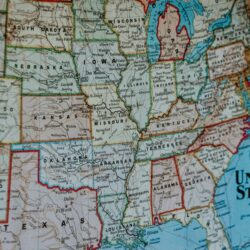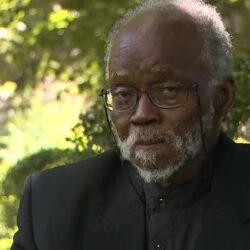A Time and Space for Climate Change in Business and Society Research
In this post, authors Christopher Wright, George Ferns, Daniel Nyberg and Sheena Vachhani reflect on their paper, “Climate Change, Business, and Society: Building Relevance in Time and Space,” published in Business & Society.
The severity of climate change was recently underscored in the latest Intergovernmental Panel on Climate Change (IPCC, 2022) assessment report: the planet is experiencing warming unseen in 125,000 years and atmospheric carbon levels are at their highest in over 2 million years. So, to what extent have business and society scholars addressed climate issues, and how can we further advance research about climate change? These central questions guided our recently published paper in Business & Society’s 60th Anniversary Special Issue.

On the positive side, despite the general neglect of climate change within mainstream business scholarship, Business & Society has published a steady stream of research addressing the business implications of climate change. In reviewing Business & Society publications over the last 20 years (2001–2021), we found 158 articles (28 percent of a total of 570 articles) mentioning “climate change” or “global warming.” This suggests that the journal’s authors and audience recognize the importance of this issue.

That said, we also found that the vast majority of this research continues to support an agenda of climate-enlightened business-as-usual. Most studies assume a harmonious compatibility between business interests and the protection of the planet, evident in the emphasis on climate responses that benefit firms through competitive advantage, superior financial returns, or improved environmental performance.
This way of prioritizing business above the natural environment—an approach mirrored in other journals that focus on business-nature relationships—is seriously limited in tackling a grand challenge such as climate change. This is echoed by many critical voices within the broader field of management and organization studies that have questioned assumptions of a “win–win” relationship between business and environmental outcomes.
So, where to go from here? Surveying the literature in Business & Society, coupled with our broader reading of literature within the humanities and social sciences, we propose a fruitful avenue of enquiry – time and space. These concepts point toward two inescapable realities – climate change is not some future threat – it is happening now and its dramatic physical impacts are already evident in many places. As scholars interested in climate issues, we need to pay much greater attention to these concepts if we wish to advance our thinking and make our research relevant for organisations and policy makers.
First, in terms of time, the inability to adequately address climate change due to the framing of time (often upon a short or medium term basis), evident in the focus on quarterly and semi-annual financial reporting. This is exemplified in recent commitments by companies to be carbon neutral by mid-century, which can be seen as a form of “predatory delay,” serving to push much needed decarbonization into a distant future. Second, regarding place, businesses are dependent on the physical environment and their embeddedness within natural systems. A business’ sense of place significantly influences how it makes sense of and seeks to adapt to climate change.

We argue that these two concepts need to be considered concurrently. The central idea is that there is no temporality of climate change without spatiality of its effects and no spatiality of events without the inscription of temporality. This basically means that as climate change happens over time, we need to consider how its progression creates physical impacts on a local level; concurrently, as business activity creates impacts on natural environments, we need to consider how these impacts move over time. Such impacts we refer to as “traces,” which are visible markers that physically show the movement of space over time—for example, paw prints in the snow or a dotted line on a piece of paper. To illustrate what this means practically, we offer three ways scholars can focus on specific climate traces to advance business-society research.
Reimagining Stakeholders
First, climate-related traces can be utilized to broaden our conceptualization of what it means to have a “stake” in the climate debate. This needs to encompass a wider set of actors, places, and nonhuman entities grounded firmly within space-time. For instance, a key issue raised by several studies on stakeholder relations focuses on the need to include marginalized voices. Naomi Klein argues that these forgotten voices are sequestered within “sacrifice zones,” or “places that, to their extractors, somehow don’t count and can therefore be poisoned, drained, or otherwise destroyed, for the supposed greater good of economic progress.”

The trace illuminates hierarchical differences between self/we and the Other, and between the boundaries that separate global North over South, man over woman, and human over animal. This is important not only in challenging the prioritization of privileged actors as “legitimate stakeholders”, but also in recognizing that forgotten “stakeholders” can retaliate and cause reputational damage by publicly shaming firms over their environmental and social destruction.
Performative Climate Risks
Second, analysing traces can highlight how climate risk is understood. Research into business efforts to model climate risk are replete with examples of energy, resource, and financial organizations continually haunted or surprised by unprecedented climate-fuelled weather events in which nature bites back and the risk calculations misfire.
The marks of a trace are never identical nor in the same place, but “move” across time and space. For instance, the unprecedented increase of carbon emissions over the last 200 years have left marks on places around the world; visible, for instance, when analyzing atmospheric changes evident in ice cores extracted from glaciers, observing eroded coastlines and disfigured mountaintop mining sites, or mapping the bleached corals of the world’s tropical reefs. Indeed, this more granular approach to locating and predicting climate impacts is exactly what climate scientists are now seeking to apply by working with insurance and financial analysts to better identify climate risks.
Privileging the Physical Environment
Third, focusing on traces inscribed in the physical environment gives non-human actors a sense of agency. After all, we now live within an age of consequences where nature is biting back, evident in daily newsfeeds of worsening extreme weather events and climate extremes. Scholars need to pay closer attention to the profound place-bound changes in natural systems that are now unfolding.

The trace is useful in that it marks out, in a material way, where injustices inflicted on natural environments have occurred and who are responsible for these injustices. For instance, rising ocean temperatures now mean that as much as 90 percent of the world’s coral reefs are critically endangered; following recent unprecedented coral bleaching over half of the corals on Australia’s Great Barrier Reef—the largest living structure on the planet— have now died. By analyzing these traces, it is possible to attribute responsibility to particular industries, firms, and nation states. For instance, the trace sheds light on the actions of specific actors—such as the fossil fuel industry—which have contributed the most to the current climate crisis.
Overall, the concept of space-time is useful for critically questioning the temporal span of supposed climate responses, the space in which these changes are supposed to happen, the human and nonhuman actors that are affected, and the political effects of these circumstances. Business and society research needs to overcome the “placelessness” and temporal deferral that currently dominates corporate thinking and ensure the climate change is integral to stakeholder relations and accountability. It is time for urgent action and that time is now!
































































































